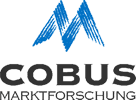Own analysis techniques
During the last years, we have developed our own analysis techniques for our clients.
These innovations come to show you that we not only can but also want to meet your unique approach.
Markt und Trendforschung mit CIMS™
COBUS Integrated Market Scan™ – Überblick
| Multidimensionale Analyse | Vier inhaltliche Säulen |
|---|---|
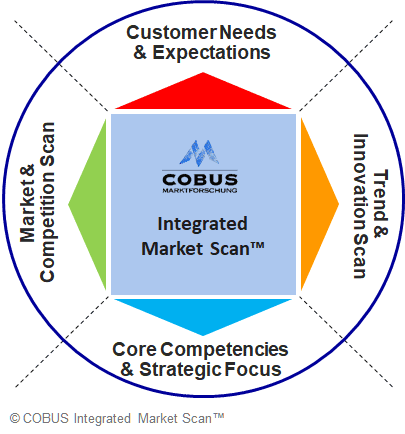 | Market & Competition Scan Gegenwart: Marktsituation inkl. typische Marktstrukturen, Marktchancen, Eintrittsbarrieren, gesetzlicher Handlungsrahmen etc. Trend & Innovation Scan Zukunft: Globale Megatrends, Produkt- und Designtrends, Technologien, innovative Vertriebs-/ Vermarktungswege, Innovationen in Wertschöpfungsketten etc. Customer Needs & Expectations Außensicht: Zielmärkte, Zielmarktsegmente, Wertschöpfungsketten etc., immer betrachtet aus der Kundensicht (B2B, B2B2C, B2C) Core Competencies & Strategic Focus Innensicht: Global, pro Land/Region, Vorstands-und Geschäftsführungsebene, operative Abteilungen wie Marketing, Vertrieb, Service, Kommunikation etc. |
COBUS Integrated Market Scan™ – Vorteile auf einen Blick
Spezifischer Methoden-Mix
Quantitative und qualitative Analysen, Insights aus Online-Screenings, Inspiration aus persönlichen Ge-sprächen, Telefoninterviews (CATI) und Workshops. COBUS schöpft für Sie alle Quellen für Innovation und Wachstum aus.
Fundierte Analyse in sehr kurzer Zeit
Auf Basis der integrierten und interdisziplinär vernetzten Vorgehensweise liegen die Analyseergebnisse und deren Interpretation unseren Kunden nach durchschnittlich drei Monaten vor. Das gilt auch für inter-nationale und multikontinentale Projekte.
Faires und attraktives Preis-Leistungsverhältnis
Im Vergleich zu Wettbewerbern erhalten COBUS Kunden umfassende Leistungen zu einem sehr fairen Preis. Das ist möglich, weil das COBUS-Team eingespielt ist, sich perfekt organisiert und Ihr Projekt international vernetzt betreut.
POS CEST®
POS CEST® (Consumer Evaluation Scanning Test)
 Not only the growing range and choice of media influences purchasing decisions increasingly but the factors of interpersonal classification (e.g. culture and societal norms, as well as class, group and family affiliation) characterise the system of values of a person.
Not only the growing range and choice of media influences purchasing decisions increasingly but the factors of interpersonal classification (e.g. culture and societal norms, as well as class, group and family affiliation) characterise the system of values of a person.
Germany is evolving into a “melting pot” of diverse cultures. Nowadays, Asiatic, African, eastern European and Turkish businesses, establishments and restaurants dominate the scene in Germany.
This fellow citizens have very particular purchasing habits, that is to say they have adapted their own purchasing habits or influenced the purchasing habits of other persons.
Social norms (e.g. the “In” and “Outs”) as well as the adscription to social and social classes (low, mid, high), groups and families, are as decisive as family structure.
 Family structure has suffered a great change in the last 10 years: The number of one and two-person households has increased substantially, just like the ones with single parents.
Family structure has suffered a great change in the last 10 years: The number of one and two-person households has increased substantially, just like the ones with single parents.
Families are moulded on the one hand via the diverse activities practised outside of the home but on the other hand also via using electronic media such as internet-surfing, online-shopping, computer-gaming, etc.
Not only these interpersonal classification factors influence purchasing decisions but also the intrapersonal classification factors do, as activation and involvement, emotions, motivations, cognitions, attitudes, values and identity which themselves build a hierarchy.
Activation describes the inner state of arousal, which is triggered by way of an emotional stimulation effect (e.g. through visualization of babies or old persons), through cognitive stimulation (e.g. contradictions or surprises), and through physical stimulation, as music, colours and smells.
In addition to activation, attention must also be aroused. The level of attention will be influenced by the involvement, the degree of “ego-involvement” (commitment) (high, low and product involvement).
Emotions are psychic agitations which are perceived subjectively as joy, fury and fear.
Emotions are either knowingly perceived by persons or visualized through inner images.
Images which are associated to specific concepts (e.g. vacation).
Motivations or even necessities align conduct towards a goal. One also identifies those as „The reason behind human behaviour”. There are various types of motivations (primary, secondary, conscious, unconscious, intrinsic and extrinsic)
Cognitions or awareness states are subjective knowledge, which is available on demand. The starting point of all cognitive processes is perception. Perception comprises the reception and selection of information, as well as its organisation and interpretation.
Attitudes or images are the inner dispositions of a person to act positively or negatively in response to a stimulus. Those are learning processes.
Values are perception about desirability as peace, justice, cleanliness, etc. Changes in values can be perceived over time.
Personality is he most complex construct of purchasing conduct, based on predispositions which are genetically conditioned as intelligence and musicality. However, these can also be conditioned by the environment.
Studies show that almost 50% of consumers purchased exactly what they had previously planned to.
This means that exactly the same proportion indulge into spontaneous purchasing.
It is in the case of spontaneous purchasing that purchasing decisions will be made right at the POS.
At this point, it becomes apparent that these spontaneous purchases can, to a great extent, be driven by means of impulses at the POS, e. g. promotions, double placements (of products on shelves), announcements or product samplings.
For the measurement of these impulses (frecuency, intensity, etc.) two research approaches exist in practice in market research at the POS:
- the study of conduct (personally or via video)
- surveys
Usually, the chief method is the survey, although this constitutes “second-hand” information, which presupposes the self-assessment of the consumer.
Consequently, observation (study of conduct) represents “first-hand” information.
Observation in biotic situations, those where consumers do not notice they are being monitored, is the form of examination.
Now POS CEST links both of these methods together.
POS CEST® is a combination of observation and survey.
With POS CEST® one can monitor, question and analyse the effectiveness of all POS-related operations (new products, product extensions, promotions, double placement, samplings, bonuses, contests).
Advertising effect with PrintCOB®
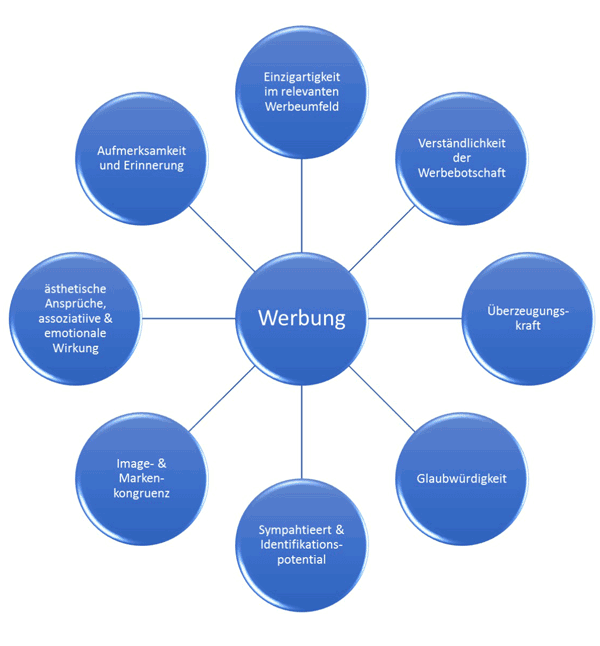
Besides measuring the degree of attention and remembrance, advertising must also be tailored to the relevant objective group with its communicative parameters. This is the only way for advertising to accomplish its communication goals. In order to analyse the advertising effect from every side, 8 dimensions must be analysed.
You receive a derivation of operational recommendations for the target-oriented optimization of your advertising. Besides, the same aspects are generally tested on the competitive environment - thus you can perform a “true Benchmarking”.
Additionally, it is possible to carry out a post-analysis – the brochures that you / your advertising agency optimised are tested by COBUS with regards to the performance of the improvement proposals.
With PrintCOB® you can test all types of printed media:
- Brochures
- Flyers
- Advertisements
- Posters
- Advertising supplements
- Mailings
MACPO®
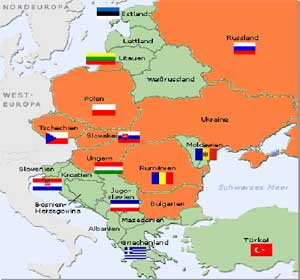
Many companies hold back on the idea of entering eastern markets. The reasons for this reserve is the lack of transparency in the eastern European markets, insecurities over their further economic development and insufficient knowledge over country-specific requirements on sales policy instruments.
Because of this resistance, many companies give away the decisive potential existing in Eastern Europe.
With our instrument of analysis maCpo (Marktpotentiale Osteuropa, German for market potential Eastern Europe) we provide you with the possibility to obtain market information of such nature as you have not had available so far. In addition to market volumes, sales potential by target group and price structures, you gain precise information about which communication channels and advertising contents can reach your target groups. Following a classification per region, you can see where your investments in marketing can give quicker returns.
OptiTek®
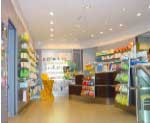 The optimisation of salesrooms in drugstores is unavoidable. The requirements of chemist’s customers have also increased in the ambit of health. Right in the age of online drugstores, traditional establishments must respond to their clientele and understand themselves as “enjoyable service providers in an appealing ambience”.
The optimisation of salesrooms in drugstores is unavoidable. The requirements of chemist’s customers have also increased in the ambit of health. Right in the age of online drugstores, traditional establishments must respond to their clientele and understand themselves as “enjoyable service providers in an appealing ambience”.
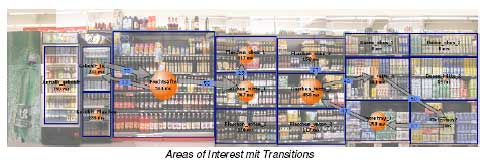
In collaboration with drugstore fitters and with the application of traditional studies, surveys and, on demand, new technical measuring methods, we guarantee the optimal installation, completely individualized for every drugstore
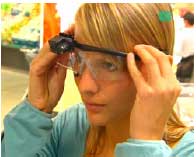 It is understood that also here merely the most efficient and effective method will be applied successfully
It is understood that also here merely the most efficient and effective method will be applied successfully
